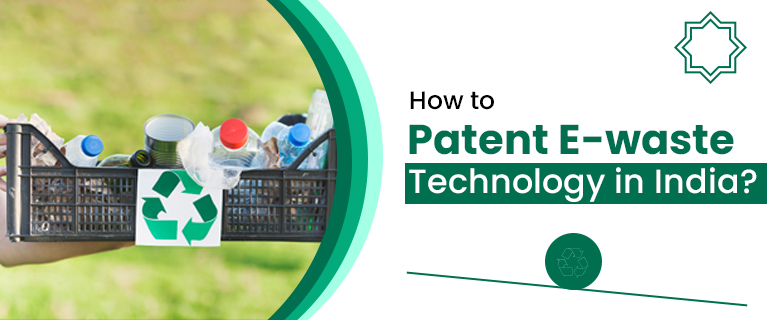How to Patent E-waste Technology in India?
The increasing proliferation of electronic devices has led to a significant rise in electronic waste or e-waste. E-waste contains various hazardous materials that pose environmental and health risks if not properly managed. To address this issue, innovative e-waste recycling technologies have emerged, offering sustainable solutions for the disposal and recycling of electronic waste. Patenting such technologies not only protects the intellectual property of inventors but also incentivizes further research and development in the field. In this blog, we will explore the process of patenting e-waste recycling technology in India and the key steps inventors should follow to protect their innovation.
1. Conduct a Prior Art Search:
Before proceeding with the patent application, it is crucial to conduct a comprehensive prior art search. This involves identifying existing patents, scientific publications, and other relevant sources of information that may disclose similar or related e-waste recycling technologies. The prior art search helps assess the novelty and inventiveness of your technology and determines if it meets the criteria for patentability.
Read also this -: How to Apply Patent Registration Online In India2. Draft a Patent Application:
Once the prior art search is complete, the next step is to draft a patent application. The application should include a detailed description of the e-waste recycling technology, highlighting its unique features and advantages. It should also include detailed drawings, diagrams, and any supporting data or experimental results that demonstrate the effectiveness of the technology. To ensure accuracy and completeness, it is advisable to seek the assistance of a patent attorney or agent experienced in the field of e-waste recycling.
3. File the Patent Application:
In India, patent applications for e-waste recycling technologies are filed with the Indian Patent Office (IPO). The application can be filed either online or by submitting a physical copy to the appropriate patent office. Along with the application, the inventor must pay the required filing fees. It is important to note that the application should be filed as early as possible to establish priority and prevent others from claiming the same invention.
4. Examination and Publication:
Once the patent application is filed, it undergoes a formal examination by the IPO. During the examination process, the patent office assesses the patentability of the technology, considering factors such as novelty, inventive step, and industrial applicability. It is common for the patent office to issue examination reports with objections or requests for clarification. The inventor must respond to these objections within the stipulated time frame to continue the examination process. Once the application meets all the requirements, the patent is published in the Official Patent Journal.
5. Grant of Patent:
If the patent office finds the e-waste recycling technology to be novel, inventive, and industrially applicable, a patent is granted. The grant of a patent provides the inventor with exclusive rights to the technology for a specified period, usually 20 years from the date of filing. With the help of these exclusive rights, producers can stop others from producing, utilising, selling, or importing their patented technology without their consent.
6. Maintenance and Commercialization:
After the grant of the patent, inventors must ensure proper maintenance of their patent by paying the necessary fees and filing required documents within the prescribed timelines. Additionally, inventors should explore opportunities for commercialising their patented e-waste recycling technology. This can involve licensing the technology to manufacturers or collaborating with industry partners to develop and implement the technology on a larger scale.
Benefits of Patenting E-waste Recycling Technology:
Patenting e-waste recycling technology offers several advantages:1. Protection of Intellectual Property: Patenting your e-waste recycling technology protects your intellectual property rights, preventing others from using or commercialising your invention without your consent. It gives you exclusive rights to exploit your innovation, providing a competitive advantage in the market.
2. Incentivizing Research and Development: Patent protection encourages further research and development in the field of e-waste recycling. Inventors are more likely to invest time, effort, and resources into developing innovative solutions when they have the assurance of intellectual property protection and the potential for commercial returns.
3. Market Differentiation and Competitive Edge: Patented e-waste recycling technologies set inventors apart from competitors. The patented status demonstrates the uniqueness and inventiveness of the technology, enhancing its market appeal and attracting potential investors, partners, or customers.
4. Potential for Licensing and Collaboration: Patent holders can explore licensing opportunities to commercialise their e-waste recycling technology. By granting licences to manufacturers or other stakeholders, inventors can generate revenue streams and foster collaborations that facilitate the widespread adoption and implementation of their technology.
5. Contribution to Sustainability: Patented e-waste recycling technologies play a crucial role in achieving sustainability goals. By protecting these innovations, inventors contribute to the global effort to reduce e-waste, conserve natural resources, and mitigate environmental and health risks associated with improper disposal of electronic devices.
Read also this -: A Guide to Applying for a Patent in IndiaConclusion
Patenting e-waste recycling technology in India is a vital step in protecting intellectual property and fostering innovation in the field. By conducting a prior art search, drafting a comprehensive patent application, and following the patenting process, inventors can secure exclusive rights to their e-waste recycling technologies. The benefits of patent protection extend beyond individual inventors, incentivizing further research, enabling commercialization, and driving the transition to a more sustainable future. By patenting their innovations, inventors contribute to the advancement of e-waste recycling practices and play a significant role in creating a cleaner and more environmentally responsible world.




Comments
Post a Comment